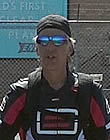|
|
 
|
|
Author
|
Topic: speco platter problem
|
|
|
|
|
|
|
John Eickhof
Jedi Master Film Handler

Posts: 588
From: Wendell, ID USA
Registered: Jan 2000
|
 posted 08-16-2018 10:27 PM
posted 08-16-2018 10:27 PM





the 'chocolate bars' are power resistors and are not your problem, they are used in line with motor when taking up film. the bridge rectifier is most likely shorted and it is a small round 8 pin plug in device at the very top of the control box, most likely you had two switches selected to the same function at the same time, do the switches light up when selected ? if so the small 24 volt transformer is good and is not causing the direct short, if they dont light then the transformer is most likely shorted, this will happen if two of the same buttons are in and also can happen if one of the button indicator lamps has dislodged from its socket and thus shorts out the unfused transformer. early speco platters had a four diode bridge soldered into the circuit in lieu of the later plug in device. they use either 4 each 10 amp 250 volt diodes or a 10 amp 250 volt square dridge rectifier, all are available at a good electronics store. one more thing, it could be a shorted drive motor, un-plug the motors and see if the fuse holds, then plug in one at a time and if the fuse blows, that motor is bad. they used field wound bodine motors. i have parts in stock for the platters but i suggest you talk with someone with more electronic knowlege than your self and repair should be very simple.
| IP: Logged
|
|
|
|
|
|
|
|
|
|
|
|
|
|
|
|
|
|
|
|
Tony Bandiera Jr
Film God

Posts: 3067
From: Moreland Idaho
Registered: Apr 2004
|
 posted 09-13-2018 08:37 PM
posted 09-13-2018 08:37 PM




quote: Monte L Fullmer
Question on this:
What purpose does the "Floating neutral" strip in the panels do in a circuit if current comes from black, flows through a circuit and heads back out on the neutral leg in the wall outlet? What happens here to get a complete circuit?
thx - Monte
Monte, the reason neutrals are isolated at all points except at the main panel (or in some cases, main disconnect), has to do with the way electricity flows.
The normal path in a circuit utilizing a neutral is the flow from hot (out from the source) through the neutral (back to the source.)
I will leave out the details of how 208, 240, and 480 volt circuits work for this discussion. (Hint: It has to do with phase angles of the alternating current.)
Now, to dispel a myth: Electricity DOES NOT SEEK GROUND! Electrical current takes ALL available paths back to its source, with the total current being divided amongst the paths based on each path's resistance. (More resistance = less current flow in that path.)
Note: The origin of the ground myth comes from the fact that the majority of electrical systems, both utilization (consumer level voltages) and distribution (and sometimes transmission) level voltages have a grounded conductor (neutral.)
The neutral is tied to a grounding electrode (ground rod) or other means to electrically bond it to earth (the ground.) This neutral/grounding connection, in a properly installed electrical system, is done ONLY at ONE point, usually the Main service panel or Main service disconnect.
Now, in the case of subpanels (very common in projection booths), and in the wiring of circuits, the neutral (grounded conductor) is kept separate from the ground grounding conductors, because normal currents on the neutral will share with the grounding conductors if they are connected. That can cause a voltage rise and sufficient current flow on the grounding conductors (and any equipment that has a grounded case, like projectors, motors, etc.)
This current, even though it is on a grounded object, can (and will) easily divide and flow though a person, with the current again in proportion to the resistances of the object and the person. This can, and most definitely has, resulted in electric shocks, electrocutions and fires.
For many years, domestic clothes dryers and ranges were permitted to use the neutral as a grounding path.. (3-prong stove/dryer cords.) The dividing currents I spoke of caused many people to get shocked (even though technically the appliance was wired correctly.) Several National Electrical Code cycles ago, that was changed. ALL NEW and rewire installations MUST be done with a 4-prong cord set (Hot, Hot, neutral, ground.) EXISTING 3-prong setups are allowed to remain in use until a rewire (or in some areas, a main or subpanel replacement) is done.
If you want to learn a lot about the hows and whys of proper grounding (handy knowledge for any tech or projectionist) search for "Mike Holt" and his Code forums and videos on the subject of grounding.
| IP: Logged
|
|
|
|
|
|
All times are Central (GMT -6:00)
|
|
Powered by Infopop Corporation
UBB.classicTM
6.3.1.2
The Film-Tech Forums are designed for various members related to the cinema industry to express their opinions, viewpoints and testimonials on various products, services and events based upon speculation, personal knowledge and factual information through use, therefore all views represented here allow no liability upon the publishers of this web site and the owners of said views assume no liability for any ill will resulting from these postings. The posts made here are for educational as well as entertainment purposes and as such anyone viewing this portion of the website must accept these views as statements of the author of that opinion
and agrees to release the authors from any and all liability.
|

 Home
Home
 Products
Products
 Store
Store
 Forum
Forum
 Warehouse
Warehouse
 Contact Us
Contact Us




 Printer-friendly view of this topic
Printer-friendly view of this topic
















